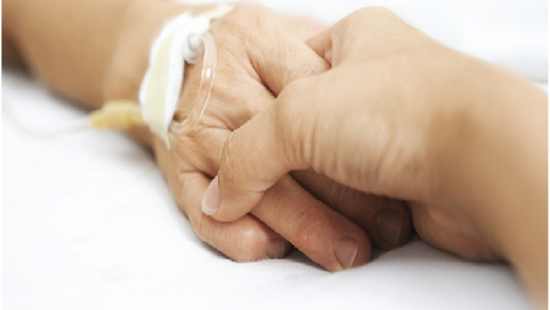The Impact of COVID-19 on HAIs and How EVS Can Fight Both

As the COVID-19 pandemic marches across the United States and the world, the focus on fundamental infection prevention measures such as hand hygiene and environmental hygiene has never been more intense in the healthcare environment.
There’s good reason for this attention. Hospital-onset transmission of COVID-19 is a significant threat. While definitions of hospital-associated COVID-19 infections have not been fully defined by researchers yet, the Wall Street Journal reports that, nationwide, hospitals have identified 5,142 coronavirus infections apparently acquired inside hospitals from May 14 to June 21, according to figures provided to The Wall Street Journal by the Centers for Disease Control and Prevention. (Wall Street Journal) And according to statistics tracked by Lost on the Frontline, a project launched by The Guardian and KHN, nearly 600 front-line health care workers appear to have died of COVID-19. (KHN) In addition to COVID-19 transmission, early signs are that traditional healthcare-associated infections (HAIs) are also on the rise as a result of the pandemic. While it’s too soon to know what the true impact of COVID-19 crisis care is on healthcare-associated infection rates, there have been a few preliminary studies and observations.
The objective of this article is to focus on the impact that SARS-CoV-2 is having on infection control infrastructure and healthcare-associated infection rates, and how a robust environmental hygiene program may help prevent transmission of SARS-CoV-2 and healthcare-associated infections during and after the pandemic.
C. difficile
McMullen et al examined their experiences in hospitals in the Midwest and New York City and offer their observations and professional opinions. (McMullen) First, let’s look at one of hospitals’ most challenging and traditionally wide-spread infection types: Hospital-onset C. difficile.
The participating hospitals have seen between 45-51% decrease in hospital onset C. difficile in their hospitals. They speculate that the contact transmission precautions necessitated by SARS-CoV-2 have caused hospitals to increase the focus on environmental cleaning and hand hygiene and will continue to have the added benefit of decreasing other organisms spread via contact transmission. They note that there may also be increased attention to environmental hygiene in more public areas such as public restrooms, waiting rooms, lobbies and cafeterias. In short, more attention to hand hygiene and environmental hygiene and more physical distancing may help prevent infections such as C. difficile that are more readily transmitted by environmental surfaces.
It should be noted that another report by Spigliaga et al predicts a higher risk of C. difficile infections due to increased antibiotic administration during the pandemic.(Spigliaga) They note that in their experience in Italy, 72% of COVID-19 patients have been treated with broad-spectrum antibiotics, which makes them more susceptible to C. difficile infections.
Surgical Site Infections (SSIs)
In regards to surgeries and related surgical site infections, McMullen et al predict fewer surgical site infections during the pandemic, not just as an artifact of fewer surgeries being performed (although that does artificially lower the infection rate), but because when fewer cases are performed each day it allows more time to address important infection prevention measures such as between-case environmental cleaning.
In a discussion of the impact of SARS-CoV-2 on ambulatory surgery centers, Dexter et al state that despite the heavier workload of dealing with COVID-19, it’s more important than ever to provide surveillance data and feedback on pathogens of concern such as Enterococcus, S. aureus, Klebsiella, Acinetobacter, Pseudomonas and Enterobacter spp.(Dexter) In their opinion, COVID-19 infectivity cannot be accounted for, population-wise, without including environmental contamination. The necessary environmental cleaning applies to the area around the patient, including the post-anesthesia care unit.(Dexter) Cleaning and other processes, significantly reduce the transmission of pathogenic bacteria and viruses—particularly important for a virus like SARS-CoV-2, which can survive on a variety of materials commonly found in ORs (e.g. stainless steel and plastic) for at least three days.
Central line-associated Blood Stream Infections (CLABSI)
Observations by McMullen et al on device-associated infections is less promising. They predict the highest impact to healthcare-associated infections from COVID-19 will occur with CLABSI.
CLABSI increased dramatically (between 327-420%) in the represented hospitals during the pandemic. The authors attribute this to multiple factors, including:
- A skew toward sicker patients being admitted in general as people with less urgent needs avoid hospitalization and those admitted with COVID-19 are more susceptible to infection.
- A tendency to place central lines in a location that is less likely to expose the healthcare worker to COVID-19, but that is more prone to cause infection.
- Less time to remove central lines timely and to attend to patients with less infection-prone venous catheters, such as peripheral IVs.
- Prone positioning of COVID-19 patients, which helps with oxygenation, but increases risk of trauma to vascular catheters that can lead to infection.
Catheter-associated Urinary Tract Infections (CAUTI)
McMullen et al also predict that catheter-associated urinary tract infections will increase, although not as dramatically as CLABSI (57-179% increases were seen in the participating hospitals) for many of the same reasons that CLABSIs increase: sicker patients who are more susceptible to infection, less time to remove catheters timely, prone positioning putting stress on the catheter and causing trauma leading to infection.
Clearly, one reason certain infection rates have increased is because in many cases infection prevention resources have been severely taxed. Attention has necessarily been diverted to manage the outbreak. Stevens et al conducted an informal Twitter poll in April 2020 to determine what percentage of traditional infection prevention time had been diverted to COVID-19 management.(Stevens) From 220 responses, they found that over 92% of respondents are spending more than half of their time on COVID-19 management efforts. Almost 80% of respondents reported spending more than three quarters of their time on COVID-19 response efforts.
The authors went on to outline the many infection prevention efforts that may be impacted by this resource constraint, including decreased bandwidth to collect, analyze and provide performance feedback on process improvement measures such as hand hygiene and environmental hygiene compliance. They predict that without investment in infection prevention resources and technology to aid in data analysis and performance feedback, “an increase in subsequent HAIs is likely.” And with increases in healthcare-associated infections may come a negative financial impact in the form of penalties associated with CMS reporting on quality programs.
The Importance of Having a Robust Environmental Hygiene Program
The Centers for Disease Prevention and Control Interim Infection Prevention and Control Recommendations for Healthcare Personnel During the Coronavirus Disease 2019 (COVID-19) Pandemic recommend taking steps to ensure that environmental cleaning and disinfection procedures are followed consistently and correctly.(CDC) The studies and observations discussed above on the impact of SARS-CoV-2 on healthcare-associated infections further validate the importance of continuing cleaning, disinfection, environmental monitoring during the pandemic.
Environmental hygiene is a combination of processes, practices and products that must be delivered consistently and effectively to protect patients from healthcare-associated infections, regardless of extenuating circumstances, such as a global pandemic. There have been several studies that have demonstrated the importance of a multimodal or programmatic approach to environmental hygiene – a combination of product + process + procedure = optimal environmental hygiene performance.
In one of the early studies that showed the connection between environmental hygiene and transmission of healthcare-associated infections from prior room occupants, Datta et al found that when staff delivered disinfectant products with saturated cleaning cloths, when they were trained on the process of cleaning high-touch objects, and when they were provided feedback on cleaning performance through use of DAZO®, a fluorescent marker to monitor environmental hygiene, then transmission of Methicillin-resistant Staphylococcus aureus (MRSA) and Vancomycin-resistant Enterococci (VRE) decreased.(Datta)
Another study in 2019 called the REACH study that was a multi-center, randomized trial conducted in 11 Australian hospitals, demonstrated that a programmatic or bundled approach to environmental hygiene decreased VRE as well.(Mitchell) Here again, the bundle consisted of optimizing product use, optimizing cleaning process, and measuring and providing feedback on cleaning performance using DAZO® fluorescent marker. Interestingly, they did not see a reduction in C. difficile infections; however, it should be noted that the use of a sporicide was not required, which likely contributed to that result.
Two recent studies further demonstrate the value of implementing a programmatic approach to environmental hygiene.
In the first study, a program that included a daily hydrogen peroxide/peroxyacetic acid sporadical disinfectant product, a focus on optimizing environmental hygiene processes, and performance feedback using DAZO® fluorescent marker tied to a performance dashboard that provided real-time, actionable data to drive improvement - was implemented in a 60-bed nonprofit, independent health system serving children with special healthcare needs – some of healthcare’s most vulnerable patients. (Craig) The objectives of this performance improvement study were to improve cleaning and disinfection and measure impact on healthcare-associated infection incidence and cost. The implementation of the bundle resulted in improving high-touch object cleaning from 37% to 90% between 2016 and 2018. They attribute this program to a 65% healthcare-associated infection reduction and an estimated cost avoidance of $500,000 over the same time period.
In the second study, researchers used simulation and modelling to compare the cost-effectiveness of 9 interventions and 8 bundles that are aimed at preventing C. difficile infection. (Barker) The 9 independent interventions that were compared included:
- Daily cleaning with sporicidal products
- Terminal cleaning with sporicidal products
- Patient hand hygiene
- Visitor hand hygiene
- Healthcare worker hand hygiene
- Visitor contact precautions
- Healthcare worker contact precautions
- Reduced intrahospital patient transfers
- Screening for asymptomatic C difficile colonization at admission
Their results showed that daily cleaning, healthcare worker hand hygiene, patient hand hygiene, terminal cleaning, and reduced patient transfers were all found to be cost saving. Importantly, daily cleaning with a sporicidal product was the most clinically effective and cost-effective intervention by far, saving $358,268, 25.9 infections, and 36.8 Quality Adjusted Life Years annually in the 200-bed model hospital.
Conclusion
SARS-CoV-2 is taxing the traditional infection control infrastructure. As a result, the studies we’ve read suggest hospitals are experiencing an increase in some healthcare-associated infections, and that as the pandemic continues we may continue to see more infections unless resources are made available to maintain a consistent level of environmental cleanliness. Environmental hygiene is an important contributor to infection prevention and using a robust environmental hygiene program may help. To be effective, this programmatic approach should incorporate efficacious and efficient products (including sporicidal disinfectants), clear, evidence-based processes and training, and objective performance monitoring technology to provide real-time actionable data back to infection prevention staff. Together, these elements may help prevent transmission of SARS-CoV-2 in hospitals as well as other healthcare-associated infections throughout the pandemic, and after.
Linda Homan, RN, BSN, CIC, is senior manager of clinical affairs for Ecolab Healthcare.
This article originally appeared in Healthcare Hygiene Magazine for its September 28, 2020 special edition issue on Environmental Hygiene Imperatives.
References:
Barker AK, Scaria E, Safdar N et al. Evaluation of the cost-effectiveness of infection control strategies to reduce hospital-onset Clostridiodes difficile infection. JAMA Netw Open. 2020;3(8):e2012522. .
Centers for Disease Control and Prevention. Interim Infection Prevention and Control Recommendations for Healthcare Personnel During the Coronavirus Disease 2019 (COVID-19) Pandemic. https://www.cdc.gov/coronavirus/2019-ncov/hcp/infection-control-recommendations.html Accessed 9/7/2020
Craig SL, Lang MDM, Schlottman KJ, Environmental Services Quality Improvement Drives Healthcare-acquired Infection Reduction. Pediatr Qual Saf 2020;2S:e280.
Datta R, Platt R, Yokoe DS et al. Environmental cleaning intervention and risk of acquiring multidrug-resistant organisms from prior room occupants. Arch Intern Med. 2011;171(6):491-494.
Dexter F, Elhakim M, Loftus RW, Seering MS, Epstein RH. Strategies for daily operating room management of ambulatory surgery centers following resolution of the acute phase of the COVID-19 pandemic. J Clin Anesth. 2020;64 https://www.ncbi.nlm.nih.gov/pmc/articles/PMC7188624/pdf/main.pdf. Accessed 07-20-20.
McMullen KM, Smith BA, Rebman T. Impact of SARS-CoV-2 on hospital-acquired infection rates in the United States: Predictions and early results. Am J Infect Control. 2020 Jul 2 doi:10.1016/j.ajic.2020.06.209 [Epub ahead of print].
Mitchell BG, Hall L, White N, et al. An environmental cleaning bundle and health-care-associated infections in hospitals (REACH): A multi-center, randomized trial. Lancet Infect Dis 2019 Apr;19(4):410-418.
Spigliaga P. COVID-19 and Clostridioides difficile infection (CDI): Possible implications for elderly patients. Anaerobe. 2020;64. Published online 2020 Jun 25. doi:10.1016/j.anaerobe.2020.102233.

Cleaner, Safer Hospitals and ASCs
Ecolab takes a programmatic approach to infection control in hospitals and Ambulatory Surgery Centers, with specialized, multi-modal solutions for patient rooms, operating rooms, central sterile departments and hand hygiene.



